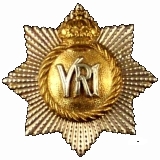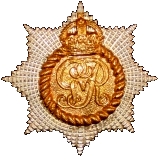
The Royal Canadian Regiment and
The First World War - 1914-1919
Signs of the Times
By Colonel A.S.A. Galloway (Reproduced from Pro Patria No. 69, August 1990.)
Recently, with the organization of 1st Canadian Infantry Division for the fourth time in 75 years, the "Old Red Patch", the divisional sign first adopted at the time of the Battle of the Somme in 1916, has made its appearance on the upper right arms of the officers and men whose units are designated as components of the division.
In both World Wars the 1st, 2nd, 3rd and 4th Canadian Divisions wore similar coloured cloth rectangles sewn on their uniforms. The same rectangles 'were painted on divisional properties. For 1st Division it was a red 'patch'; for the 2nd it was blue, for the 3rd it was French grey and for the 4th Division it was green. In World War II there was a 5th Division and its patch was maroon. In that war both the 4th and 5th Divisions were armoured.
Canada's World War I divisions were all infantry divisions, each consisting of three infantry brigades and each brigade of four battalions. Since the basic firepower was provided by the rifle, each battalion had an establishment of 1,100 all ranks, somewhat larger than the World War II and present day battalions. With four battalions to a brigade the World War I infantry brigade had almost twice the number of infantry found in the World War II or present day brigades.
British army divisions wore heraldic devices or some form of logo as divisional signs. Since there were more than fifty British divisions in World War I, no systematic colour scheme as used by the Canadian army could be adopted. The Canadian system was a clever one indeed, simple in design and very easy to interpret.
During World War I, not only the divisional 'patch' was worn, but each battalion, and the brigade it was in, was quickly recognized by smaller cloth shapes sewn above the divisional sign. This was not the case in World War II when the regimental shoulder 'flash', or 'jam label' bearing the unit's full name, or abbreviation for its name, came into being. During World War II no indication of the brigade was worn on the uniform, except by brigade headquarters personnel.
Canada's World War I system was based on the seniority of each battalion in its brigade. In addition, each brigade had a different coloured shape. Thus, for the first brigade in each division -- the shape was green. It was red for the second brigade and blue for the third brigade. Therefore, the 1st, 4th, 7th and 10th brigades all had a small green patch (or shape) above their divisional patch, whereas the 2nd, 5th, 8th and 11th brigades had small red shapes and the 3rd, 6th, 9th and 12th brigades had small blue shapes.
The shape of the small patch in each of the senior battalions was a solid circle (or disc), of the next senior a solid half-circle, of the third senior a solid triangle and of the fourth a solid square. This was indeed a clever system, as the circle meant one line only, the semicircle two lines, the triangle three lines and the square four lines. Brigade headquarters personnel wore a narrow bar in the brigade colour across the top of the divisional patch. The system looked like this:

It will be recalled that during World War I only The Royal Canadian Regiment and Princess Patricia's Canadian Light Infantry had regimental names, the other forty-six infantry battalions, including one brigade whose infantry battalions were designated "mounted rifles", were formed from amalgamating militia regiments and giving them numbers.
At the beginning of World War I The Royal Canadian Regiment was the first unit to go overseas, but it spent the first few months of the war garrisoning Bermuda. The PPCLI was formed from British ex-regulars and Boer War veterans. and went overseas to be part of a British brigade for several months. The 1st and 2nd Canadian Divisions arrived in France as divisions in 1915, whereas that same year the 3rd Canadian Division was formed in France when The RCR arrived from Bermuda, the PPCLI was released from the British army, and the 42nd and 49th Battalions arrived from Canada. The 42nd was allowed the title "Black Watch" in brackets after its number, whereas the 49th Battalion became the Edmonton Regiment after World War I. During World War II it was granted the prefix Loyal, becoming the Loyal Edmonton Regiment (or LER) on becoming allied to the Loyal Regiment of the British army.
It should perhaps be pointed out that 4 RCR, originally the 7th Fusiliers, and between the wars the Canadian Fusiliers, formed the nucleus for the WWI 1st Battalion (Western Ontario Regiment) which unit won for us the Battle Honours Ypres 1915, Gravenstafel, St. Julien and Festubert 1915. As the senior battalion of the 1st Brigade its sign was the green solid circle over the red patch, whereas The RCR was the green solid circle over the French grey patch, as senior battalion of the "Shiny Seventh Brigade".
During the 1930's, as some of the former pre-war PF members may recall, the World War I divisional-brigade-unit combination patch was still in use, being painted on boards over the doors of numerous Wolseley Barracks' buildings such as the canteen, QM stores, etc. However, the device was not worn after demobilization in 1919. Incidentally, these battle patches were worn on both arms in both wars, not only on the right arm as the Old Red Patch is worn today, which in this writer's opinion, negates its supposed use by fifty percent.
ASAG
Pro Patria
- The O'Leary Collection; Medals of The Royal Canadian Regiment.
- Researching Canadian Soldiers of the First World War
- Researching The Royal Canadian Regiment
- The RCR in the First World War
- Badges of The RCR
- The Senior Subaltern
- The Minute Book (blog)
- Rogue Papers
- Tactical Primers
- The Regimental Library
- Battle Honours
- Perpetuation of the CEF
- A Miscellany
- Quotes
- The Frontenac Times
- Site Map

![]() The RCR in the Great War
The RCR in the Great War
![]() War Diary
War Diary
![]() Battle Honours
Battle Honours
![]() Battle Bars and The RCR
Battle Bars and The RCR
![]() The RCR Battle Bar Ledger (pdf)
The RCR Battle Bar Ledger (pdf)
![]() Honours and Awards
Honours and Awards
![]() Roll of Honour
Roll of Honour
![]() Prisoners of War
Prisoners of War
![]() Cemetery List
Cemetery List
![]() Cemetery Map
Cemetery Map
![]() Courts Martial
Courts Martial
![]() Officers
Officers
![]() RSMs of The RCR (1914-1919)
RSMs of The RCR (1914-1919)
![]() NCOs and Soldiers
NCOs and Soldiers
![]() An Officer's Diary (1914-1918)
An Officer's Diary (1914-1918)
![]() Recollections of a Nonagenerian (R. England) (1916-1919)
Recollections of a Nonagenerian (R. England) (1916-1919)
![]() On to Bermuda (1914-15)
On to Bermuda (1914-15)
![]() England and France 1915-1916 (Hayes; 1931)
England and France 1915-1916 (Hayes; 1931)
![]() Overseas with The Royals (1915)
Overseas with The Royals (1915)
![]() Regimental History Pamphlet (1917)
Regimental History Pamphlet (1917)
![]() Amiens (1918)
Amiens (1918)
![]() Cambrai (1918)
Cambrai (1918)
![]() Monchy-le-Preux (1918)
Monchy-le-Preux (1918)
![]() Under-aged Soldiers in The RCR
Under-aged Soldiers in The RCR
![]() Not All Were Volunteers; The RCR and the Military Service Act
Not All Were Volunteers; The RCR and the Military Service Act
![]() Sentenced to Death by Court Martial
Sentenced to Death by Court Martial
![]() The 7th Trench Mortar Battery
The 7th Trench Mortar Battery
![]() A Regimental Goat
A Regimental Goat
![]() Regiment and Family, Bermuda 1914-15
Regiment and Family, Bermuda 1914-15
![]() "March the Guilty Bastard In"
"March the Guilty Bastard In"
![]() Surrendered as Stowaway
Surrendered as Stowaway
![]() Re-Visiting the Great War Roll of Honour for The RCR
Re-Visiting the Great War Roll of Honour for The RCR
![]() Canadian Corps Trench Standing Orders (1916)
Canadian Corps Trench Standing Orders (1916)

